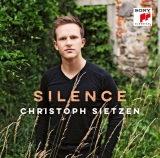 Silence; Philip Glass: Opening aus Glassworks; Isaac Albeniz: Asturias; Johann Sebastian Bach: Lautensuite BWV 996 + Largo aus Cembalokonzert f-Moll BWV 1056 für 2 Marimbas & Orchester; Francisco Tarrega: Recuerdos de la Alhambra; Astor Piazzolla: Verano Porteno + Romantico; Arvo Pärt: Spiegel im Spiegel für Marimba, Percussion & Cello; Christoph Sietzen, Marimba & Schlagzeug, Bogdan Bacanu, Marimba, Clemens Hagen, Cello, Academy of Ancient Music; 1 CD Sony Classical 190759932520; Aufnahme 08/2019, Veröffentlichung 11/10/2019 (57'15) – Rezension von Remy Franck
Silence; Philip Glass: Opening aus Glassworks; Isaac Albeniz: Asturias; Johann Sebastian Bach: Lautensuite BWV 996 + Largo aus Cembalokonzert f-Moll BWV 1056 für 2 Marimbas & Orchester; Francisco Tarrega: Recuerdos de la Alhambra; Astor Piazzolla: Verano Porteno + Romantico; Arvo Pärt: Spiegel im Spiegel für Marimba, Percussion & Cello; Christoph Sietzen, Marimba & Schlagzeug, Bogdan Bacanu, Marimba, Clemens Hagen, Cello, Academy of Ancient Music; 1 CD Sony Classical 190759932520; Aufnahme 08/2019, Veröffentlichung 11/10/2019 (57'15) – Rezension von Remy Franck

Das Cover der CD ist eher prosaisch und steht in keiner Relation zu dem musikalischen Inhalt, denn Christoph Sietzen gelangt mit seiner dritten CD auf eine neue Hochebene seiner Kunst. Gleich in Philipp Glass’ Opening weiht er das Publikum in die Geheimnisse seines Spieles ein: Er huldigt der Stille und differenziert die Atmosphäre des Leisen mit einer schier unglaublichen Nuancierungskraft und einer ungemein subtilen Führung von Crescendi und Decrescendi, die beim Zuhörer Spannung und Konzentration erwecken. Vor allem die Decrescendi, manchmal sehr spontan vorgenommen, gehen mit emotionaler Kraft in den Bauch, und die zartesten Marimbatöne werden dann zum überwältigenden Erlebnis. Sietzen führt uns tatsächlich bis in die Stille hinein. Dort liegt das Zentrum seiner Kraft, dort holt er neuen Atem, um die Intensität des Klangs auch im feinsten Pianissimo prägnant zu gestalten.
Auch die anderen Stücke, insbesondre jene von Albeniz, Tarrega und Piazzolla, sind voller Sinnlichkeit. Sphärisch schwingende Klänge erhalten durch einzelne scharfkantige Töne kraftvolle Akzente. Dann wieder animieren hauchzarte Klänge uns, in eine friedvolle Stille einzutauchen.
Wie die meisten Stücke dieser CD hat Sietzen auch die Lautensuite von Johann Sebastian Bach selbst für Marimba arrangiert. Er spielt sie mit feinster Delikatesse und nicht ohne einen Anflug von Melancholie.
Für Spiegel im Spiegel, 1978 von Arvo Pärt geschrieben, entschied er sich für die Fassung für Klavier und Cello und ersetzte den Klavierpart durch Marimba, Gong und Crotales. Zusammen mit dem Cellisten Clemens Hagen gelingt ihm eine expressive Interpretation mit hohem Mystifizierungsquotient.
Das Largo aus Johann Sebastian Bachs Cembalokonzert in f-Moll stammt aus einem Live-Mitschnitt mit der Academy of Ancient Music, wobei Bogdan Bacanu als zweiter Marimba-Spieler auftritt, so wie das schon auf der CD der Fall war, auf der Sietzen und das Wave Quartet eine Reihe von Cembalokonzerten von Bach mit dem Orfeo Barockorchester spielen und die von uns eine sehr positive Rezension erhielt.
Nun erlangt diese neue CD nicht nur durch das geniale Spiel von Christoph Sietzen seine Wirkung, sondern durch eine ebenfalls herausragende Tonaufnahme. Die Darstellung feinster Klänge und kräftiger Akzente ist absolut perfekt. Es ist zwar nur eine Stereoaufnahme, aber diese hat so viel sonores, quasi dreidimensionales Relief, dass man glaubt, eine Surround-Einspielung zu hören.
The cover of this CD is rather prosaic and does not correspond to the musical content. With his third CD Christoph Sietzen reaches a new level of his art. In Philipp Glass’ Opening he immediately introduces the audience to the secrets of his playing: He leads us into the silence. There lies the centre of his power, there he takes new breath to concisely create the intensity of the sound even in the finest pianissimo. He is able to differentiate the atmosphere of silence with an almost unbelievable power of nuance and a subtle management of Crescendi and Decrescendi. Especially the Decrescendi, sometimes performed very spontaneously, have a lot of emotional power, and the most delicate marimba tones then become an overwhelming experience.
The other pieces, especially those by Albeniz, Tarrega and Piazzolla, are also full of sensuality. Spherically vibrating sounds receive powerful accents through single sharp-edged tones. Then again, extremely delicate sounds animate us to dive into a peaceful silence.
Like most of the pieces on this CD, Sietzen has also arranged Johann Sebastian Bach’s lute suite for marimba. He plays it with the finest delicacy and not without a touch of melancholy.
For Spiegel im Spiegel, written in 1978 by Arvo Pärt, he opted for the version for piano and cello and replaced the piano part with marimba, gong and crotales. Together with the cellist Clemens Hagen he delivers an expressive performance with a high mystification quotient.
The Largo from Johann Sebastian Bach’s Harpsichord Concerto in F minor comes from a live recording with the Academy of Ancient Music, in which Bogdan Bacanu appears as second marimba player, like on the CD on which Sietzen and the Wave Quartet play a series of Bach harpsichord concertos with the Orfeo Baroque Orchestra and which received a very positive review from us.
Now this new CD not only is so overwhelming because of Christoph Sietzen’s ingenious playing, but also because of an outstanding sound recording. It’s only a stereo recording, but it has such a sonorous, three-dimensional relief that you might think you’re listening to a surround recording.
























